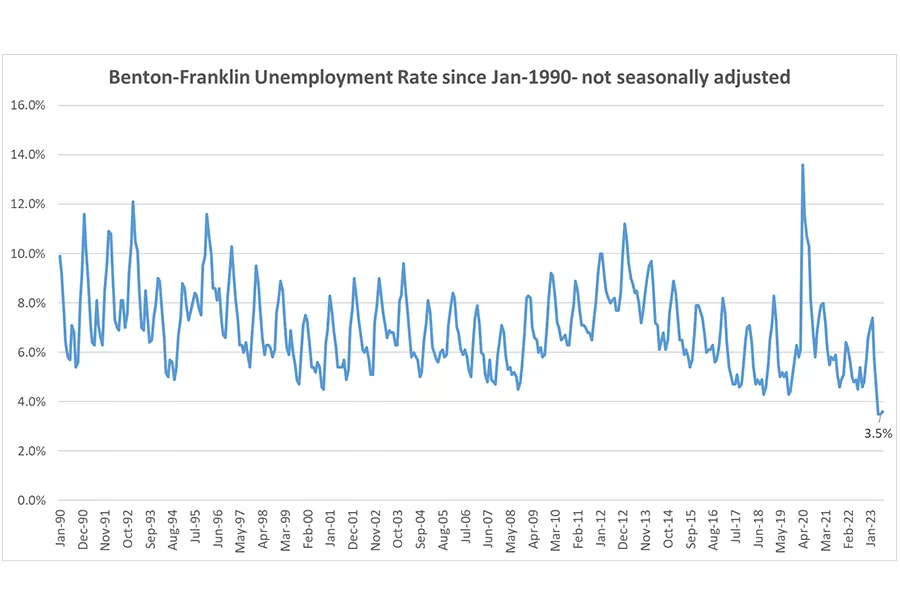
Home » Historically low unemployment rates provide opportunities and challenges
Historically low unemployment rates provide opportunities and challenges

September 14, 2023
With high inflation, high interest rates and an overall higher cost of living, one key market figure has been trending with record lows since the Covid-19 pandemic ended: the unemployment rate.
At 3.6%, the rate for the Tri-Cities area is well under the area’s typical historic range of 5% to 6%.
These rates, the most recently available, are down from the previous month’s 3.5% and a full percentage point lower compared to the same time last year when unemployment reached 4.5%.
The last time the area hit 4.5% was 16 years ago in July 2007, said Ajsa Suljic, a regional labor economist with the Employment Security Department (ESD) based in Kennewick.
Statewide, unemployment is 3.6%, trailing the nation’s 3.5%. It’s been 54 years since the national unemployment rate hit 3.4%, which happened earlier this year.
Low unemployment rates can be a catch-22, Suljic said.
“It’s a good sign that there’s less people on unemployment, but it’s a tough situation for many businesses looking to hire,” she said.
For employers, fewer workers seeking jobs means a smaller applicant pool and the pressure to offer more incentives.
“Employers compete for those people looking, which increases the wages, so the upward increase in wages is also at a historic high,” said Doug Tweedy, an ESD regional labor economist based out of Spokane.
Those receiving unemployment benefits are finding it doesn’t take as long to find their next job. Suljic said most people receive benefits for less than four weeks on average currently, compared to the norm of 27 weeks in the past.
Over the same one-year period, the number of jobs has continued to increase with 52,000 jobs added across the state.
About 5,500 people in Benton and Franklin counties are seeking jobs, when historically it typically hovers between 8,000 to 9,000. This time last year, as the unemployment rate began to fall, there were about 7,000 people looking for work.
When unemployment is higher, “employers get to pick a quality workforce and seek those workers with the skills and abilities for the jobs they’re hiring for,” Suljic said.
Baby Boomers retire
Labor force officials say the biggest contributing factor to low unemployment is the retirement of the Baby Boomer generation, which accelerated during the pandemic when many opted to leave the workforce and never returned.
The entry of new workers into the workforce continues to lag behind those leaving.
The Tri-Cities saw a rapid recovery from the pandemic. Over the past year, about 2,800 jobs were added, an increase of 2.3%.
The age of the workforce in the Tri-Cities also helps.
“We still stand as one of the leading labor supplies in the state because of our younger labor population. We have around 32% of all people 18 years and under who are in schools and possibly looking for jobs. The low unemployment rate is a good opportunity for them to get into internships and on-the-job training,” Suljic said.
When unemployment rates trend higher, first-time job seekers and those with less experience have a harder time finding a position.
“Our community benefited from good population growth, in-migration and natural changes, so we’ll see how both population growth and labor force growth and implementation of technology plays a role going down the road,” Suljic said.
An increasingly diversified economy with a robust agricultural sector boasting some of the biggest food processing facilities in the country, a strong STEM presence and a burgeoning warehousing and wholesale/retail trade sector, also insulates the Tri-Cities’ economy.
Evolving job market
As the younger generations enter the workforce, it’s clear they aren’t as interested in the same jobs their parents and grandparents worked.
Tweedy said a lot of young workers are more interested in information technology jobs.
“A lot of people are shifting away from hard labor and long hours. Even if they’re paid a lot, they’re looking for different options that offer short hours, light labor and make good money,” Suljic said. “The retail, the trades, food and hospitality sectors are still hard labor, long hours and unpredictable schedules and they’re struggling because of that.”
This is leading to labor shortages in these and other areas like health care, construction and other trades, Tweedy said.
“The challenges to employers in those industries is how do they attract workers to careers that may not be on the radar of that generation. So, what happens is they increase wages; the fastest wage increase that we’re seeing is in those trades and semi-skilled jobs,” he said, adding that it’s important to develop a diversified labor pipeline from colleges and high schools.
Suljic said the labor market may continue to tighten through the second quarter of next year before it begins to ease off.
Local News Labor & Employment
KEYWORDS september 2023





